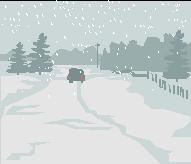
Preparation.....
Low winter sun and frosty mornings can cause drivers many problems just seeing where they are going; so be sure to keep all the glass in your vehicle clean - inside and out, as this will help to cut down on glare. Check your screen washers and keep the fluid topped up with a good quality anti-smear/anti-freeze additive, and replace worn wiper blades.
Don’t be tempted to drive off whilst your windows are still covered in ice, wait until your de-icer/heater has done its job or clear the glass with a scraper; and don’t pour hot water onto iced up glass – it’s a good way to crack it. Remember that anything other than full vision through the windows can land you with penalty points on your licence, or even worse, you may cause an accident.
Next, don’t leave the engine running to warm up whilst you nip inside for a hot drink – firstly if the vehicle is “nicked” because you left the keys in it you won’t be insured, and secondly it’s not good for the engine or the environment.
Air conditioning is useful as it dries the incoming air, and is therefore good for demisting windows quickly when used in conjunction with the heater – just be aware it does use a bit extra fuel.
It’s always good to be prepared for problems, so carry a high visibility coat for use in emergencies so you can be seen more easily, and an old rug or hessian sack which can be placed in front of the driving wheels to give more grip in snow and ice to get you going. Carry some emergency rations too, including high energy food and drink, as this can keep you feeling better and make you less susceptible to the cold.
Even if you know your route, satellite navigation systems can be very useful if you have to take a diversion caused by the bad weather or accidents. If you have a mobile phone make sure it is fully charged and you take it with you, so that you can call for assistance if needed.
Driving in snow and ice
The first golden rule is to leave loads of space between you and the next vehicle in snow and icy conditions when stopping distances can be increased TEN fold.
Keep your speed down, use very gentle acceleration and braking, and smooth steering movements so as to reduce the risk of inducing a skid.
Be extra vigilant in your observations so you can pick up on other small clues and anticipate problems sooner. Attempt to follow in the path of other vehicles if you cannot see clearly where the edges of the road are (but try not to follow them into a ditch!).
If your vehicle does start to lose traction or slide, ease off the gas immediately and broadly speaking at lower speeds steer into the slide until some control is regained. If braking in a vehicle fitted with ABS and other stability control devices, the follow the advice in the vehicle handbook, but generally steer in the direction you wish to go, so that the technology knows what’s required and can attempt to deliver it. Remember if the wheels are locked you have no control over where the vehicle goes!
Moving away in 2nd gear helps to reduce wheel spin – automatic vehicle often have a winter position which does this for you, if not use the manual over-ride. Vehicles fitted with traction control should take care of this problem automatically by reducing the engine power.
Make sure you know what safety aids are fitted to your vehicle as pumping the brakes on a vehicle fitted with ABS can be counterproductive for example.

